battery MAZDA PROTEGE 1992 Manual Online
[x] Cancel search | Manufacturer: MAZDA, Model Year: 1992, Model line: PROTEGE, Model: MAZDA PROTEGE 1992Pages: 1164, PDF Size: 81.9 MB
Page 391 of 1164
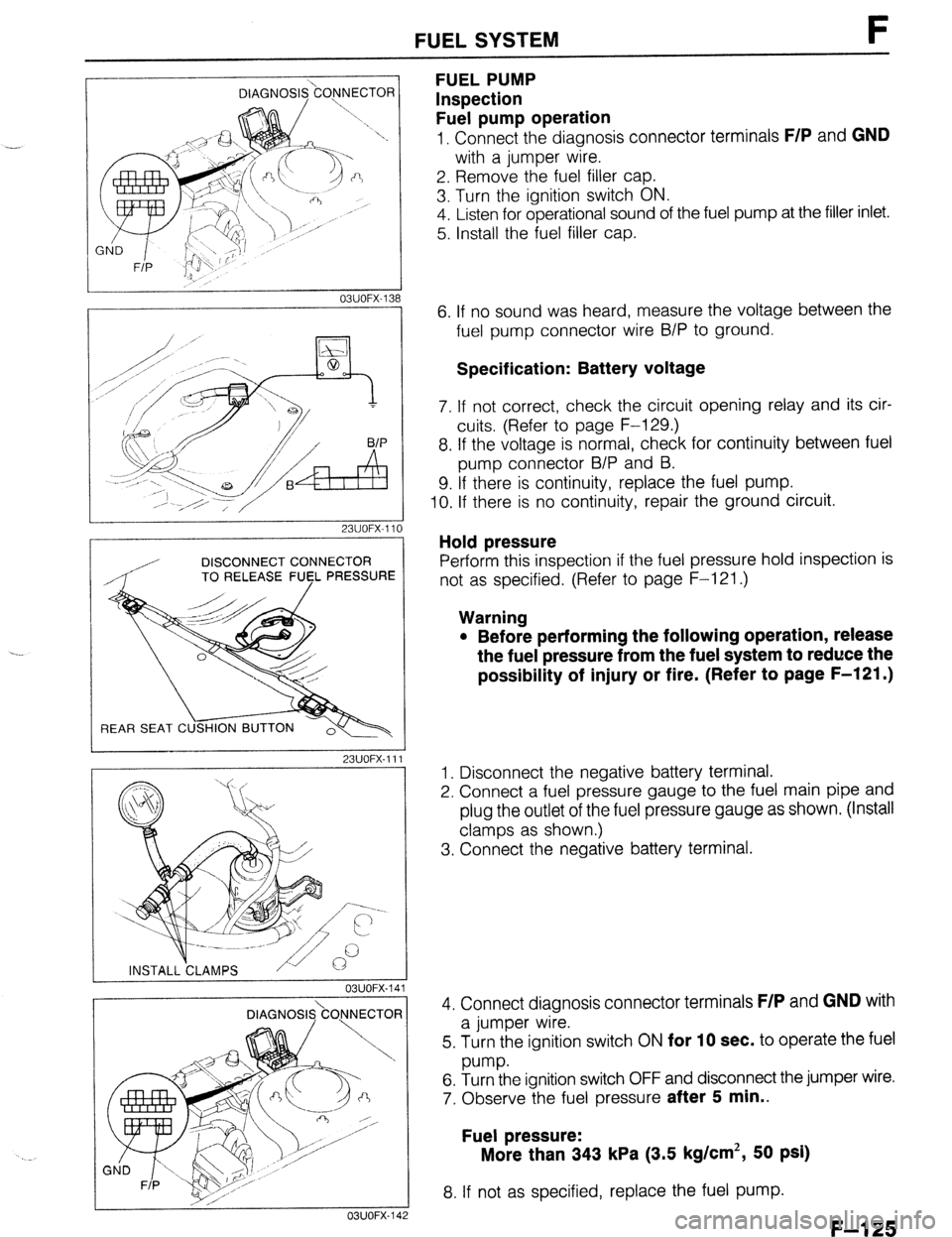
FUEL SYSTEM F
DIAGNOSI&ONNECTOR
03UOFX-138
I I 23UOFX-110
,
DISCONNECT CONNECTOR
REAR SEAT C
23UOFX-11
03UOFX-11
OBUOFX-11
FUEL PUMP
Inspection
Fuel pump operation
1, Connect the diagnosis connector terminals F/P and GND
with a jumper wire.
2. Remove the fuel filler cap.
3. Turn the ignition switch ON.
4. Listen for operational sound of the fuel pump at the filler inlet.
5. Install the fuel filler cap.
6. If no sound was heard, measure the voltage between the
fuel pump connector wire B/P to ground.
Specification: Battery voltage
7. If not correct, check the circuit opening relay and its cir-
cuits (Refer to page F-129.)
8. If the voltage is normal, check for continuity between fuel
pump connector B/P and B.
9. If there is continuity, replace the fuel pump.
IO. If there is no continuity, repair the ground circuit.
Hold pressure
Perform this inspection if the fuel pressure hold inspection is
not as specified. (Refer to page F-121 .)
Warning
l Before performing the following operation, release
the fuel pressure from the fuel system to reduce the
possibility of injury or fire. (Refer to page F-121 .)
1. Disconnect the negative battery terminal.
2. Connect a fuel pressure gauge to the fuel main pipe and
plug the outlet of the fuel pressure gauge as shown. (Install
clamps as shown.)
3. Connect the negative battery terminal.
4. Connect diagnosis connector terminals
F/P and GND with
a jumper wire.
5. Turn the ignition switch ON
for 10 sec. to operate the fuel
w-w.
6. Turn the ignition switch OFF and disconnect the jumper wire.
7. Observe the fuel pressure
after 5 min..
Fuel pressure:
More than 343 kPa (3.5 kg/cm’, 50 psi)
8. If not as specified, replace the fuel pump.
F-l 25
Page 392 of 1164
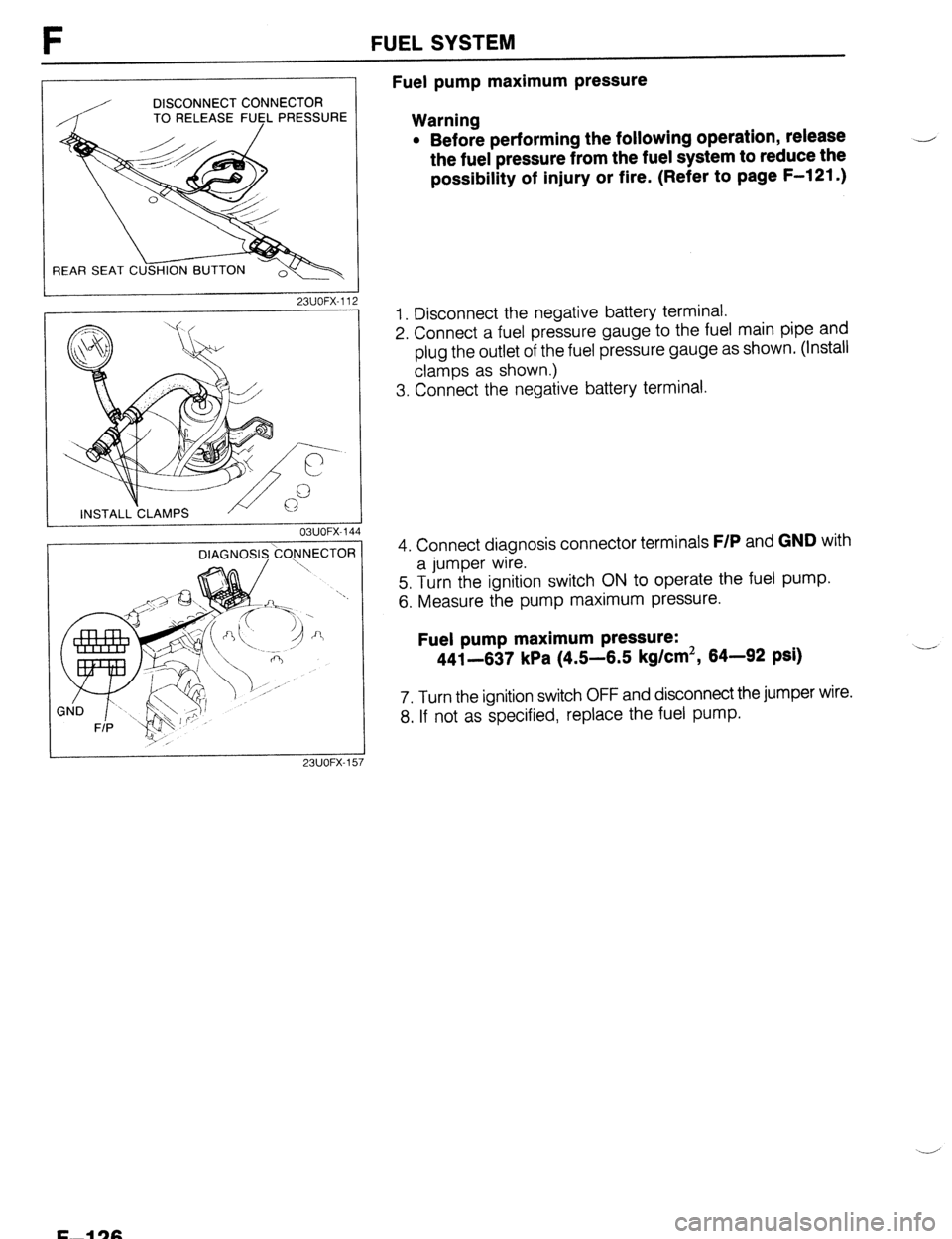
FUEL SYSTEM
Fuel pump maximum pressure
DISCONNECT CONNECTOR
TO RELEASE FUCL PRESSURE
Warning
23UOFX-11
OBUOFX-144 l
Before performing the following operation, release
the fuel pressure from the fuel system to reduce the
possibility of injury or fire. (Refer to page F-121 .) 4
1
2
23UOFX-15 7
1. Disconnect the negative battery terminal.
2. Connect a fuel pressure gauge to the fuel main pipe and
plug the outlet of the fuel pressure gauge as shown. (Install
clamps as shown.)
3. Connect the negative battery terminal.
4. Connect diagnosis connector terminals
F/P and GND with
a jumper wire.
5. Turn the ignition switch ON to operate the fuel pump.
6. Measure the pump maximum pressure.
Fuel pump maximum pressure:
441-637 kPa (4.5-6.5 kg/cm2, 64-92 psi) .--
7. Turn the ignition switch OFF and disconnect the jumper wire.
8. If not as specified, replace the fuel pump.
F-l 26
Page 395 of 1164
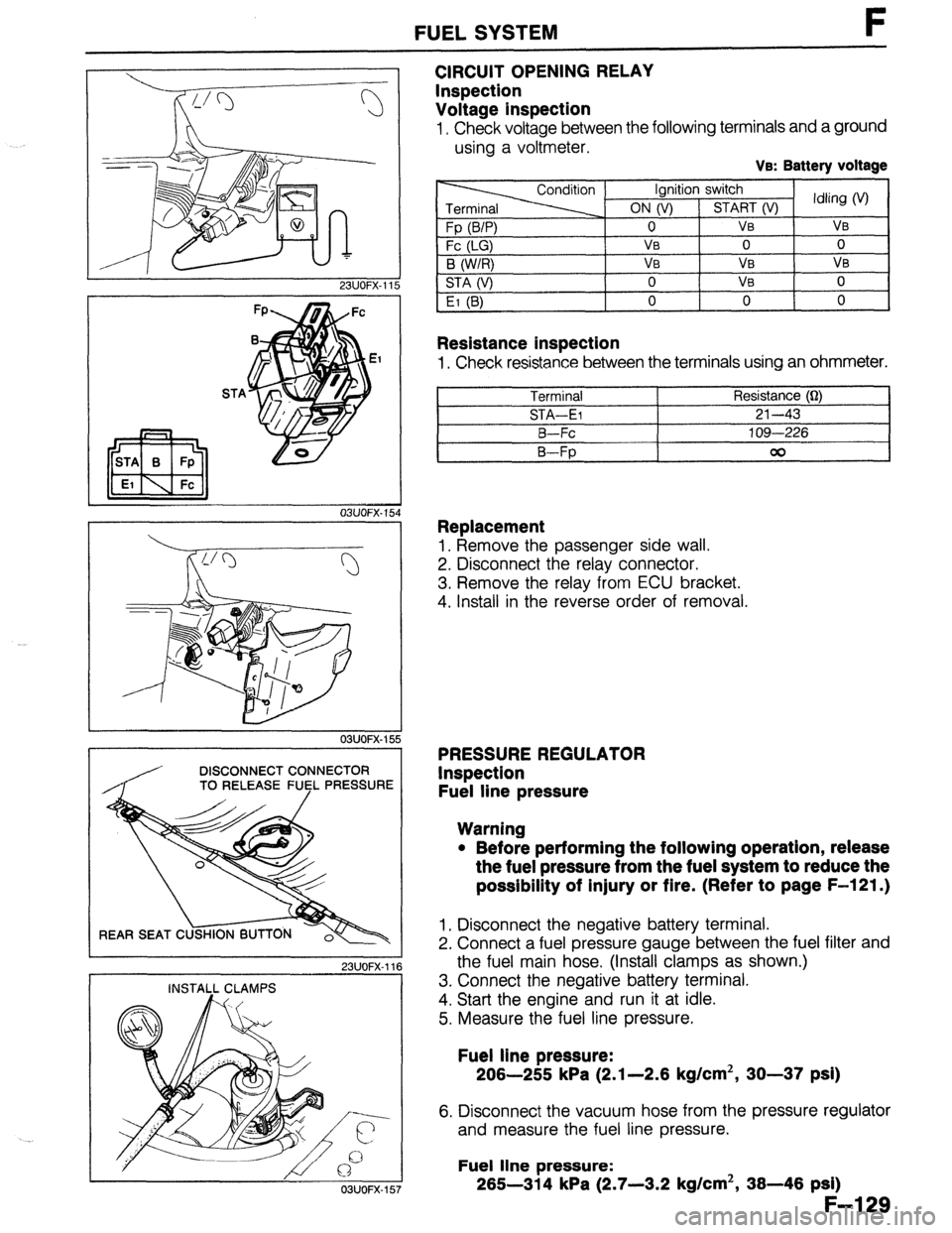
FUEL SYSTEM F
STA
OBUOFX- 15
03UOFX-15
DISCONNECT CONNECTOR
TO RELEASE FUfL PRESSURE
REAR SEAT C
23UOFX-11
INSTALL CLAMPS
CIRCUIT OPENING RELAY
Inspection
Voltage inspection
I, Check voltage between the following terminals and a ground
using a voltmeter.
Ve: Battery voltage
Resistance inspection
1, Check resistance between the terminals using an ohmmeter.
Terminal Resistance (Q)
STA-El 21-43
B-Fc 109-226
B-Fp 00
Replacement
1, Remove the passenger side wall.
2. Disconnect the relay connector.
3. Remove the relay from ECU bracket.
4. Install in the reverse order of removal.
PRESSURE REGULATOR
Inspection
Fuel line pressure
Warning
l Before performing the following operation, release
the fuel pressure from the fuel system to reduce the
possibility of injury or fire. (Refer to page F-121.)
1, Disconnect the negative battery terminal.
2. Connect a fuel pressure gauge between the fuel filter and
the fuel main hose. (Install clamps as shown.)
3. Connect the negative battery terminal.
4. Start the engine and run it at idle.
5. Measure the fuel line pressure.
Fuel line pressure:
206-255 kPa (2.1-2.6 kg/cm2, 30-37 psi)
6. Disconnect the vacuum hose from the pressure regulator
and measure the fuel line pressure.
Fuel line pressure:
265-314 kPa (2.7-3.2 kg/cm2, 36-46 psi)
F-l 29
03UOFX-157
Page 396 of 1164
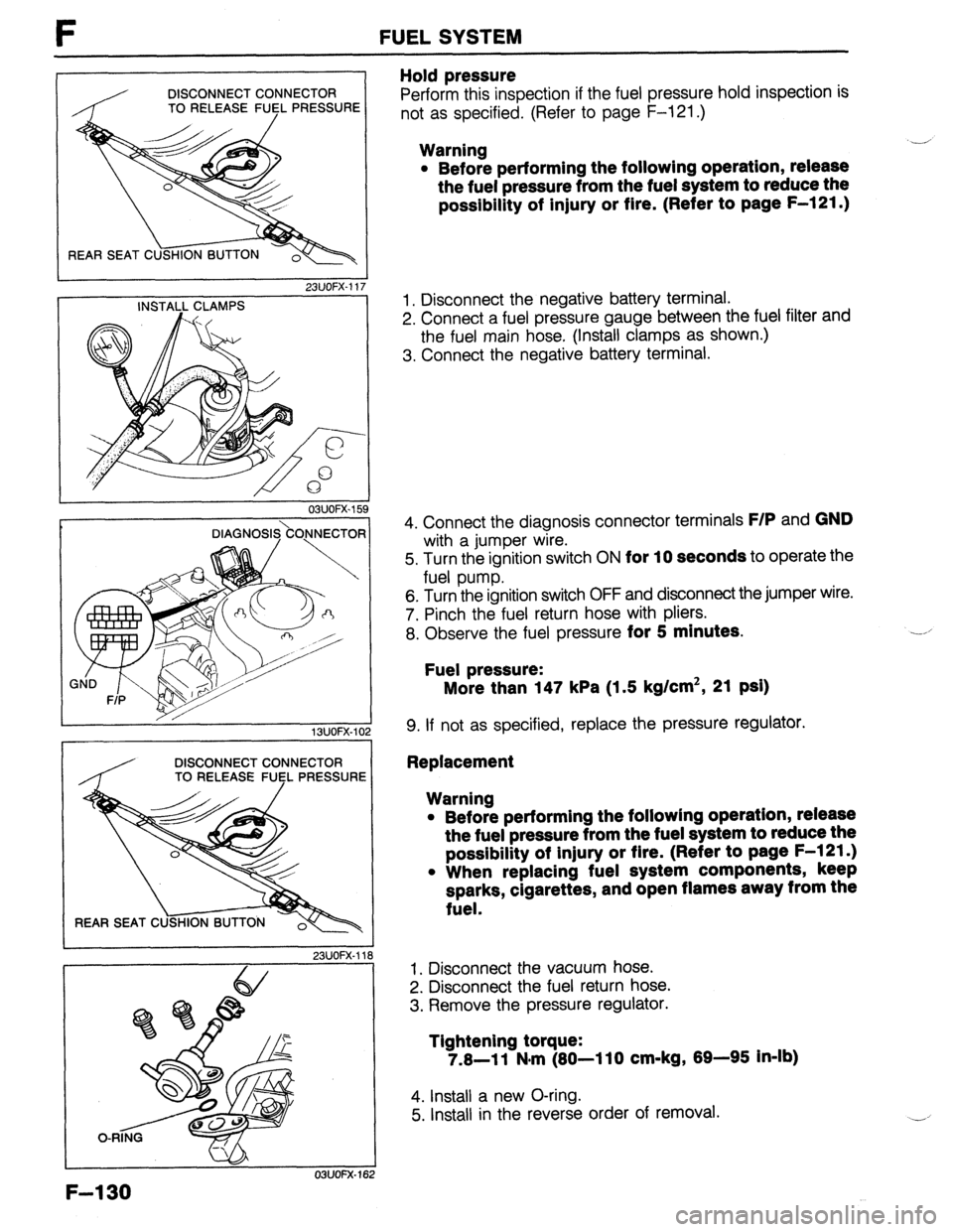
F FUELSYSTEM
DISCONNECT CONNECTOR
TO RELEASE FlJ$L PRESSURE
REAR SEAT C
23UOFX-11
INSTALL CLAMPS 7
03UOFX.I 59
F-l 30
DIAGNOSl&OJNECTOR
/ K
1 SUOFX-10
DISCONNECT CONNECTOR
TO RELEASE
FlJl$L PRESSURE
23UOFX-11
I
Hold pressure
Perform this inspection if the fuel pressure hold inspection is
not as specified. (Refer to page F-121 .)
Warning
l Before performing the following operation, release
the fuel pressure from the fuel system to reduce the
possibility of injury or fire. (Refer to page F-121 .) ,-
1. Disconnect the negative battery terminal.
2. Connect a fuel pressure gauge between the fuel filter and
the fuel main hose. (Install clamps as shown.)
3. Connect the negative battery terminal.
4. Connect the diagnosis connector terminals
F/P and GND
with a jumper wire.
5. Turn the ignition switch ON
for 10 seconds to operate the
fuel pump.
6. Turn the ignition switch OFF and disconnect the jumper wire.
7. Pinch the fuel return hose with pliers.
8. Observe the fuel pressure
for 5 minutes.
Fuel pressure:
More than 147 kPa (1.5 kg/cm2, 21 psi)
9. If not as specified, replace the pressure regulator.
Replacement
Warning
l Before performing the followlng operation, release
the fuel pressure from the fuel system to reduce the
possibility of injury or flre. (Refer to page F-l 21.)
l When replacing fuel system components, keep
sparks, cigarettes, and open flames away from the
fuel.
1. Disconnect the vacuum hose.
2. Disconnect the fuel return hose.
3. Remove the pressure regulator.
Tightening torque:
7.8-11 N#m (80-110 cm-kg, 89-95 In-lb)
4. Install a new O-ring.
5. Install in the reverse order of removal.
Page 401 of 1164
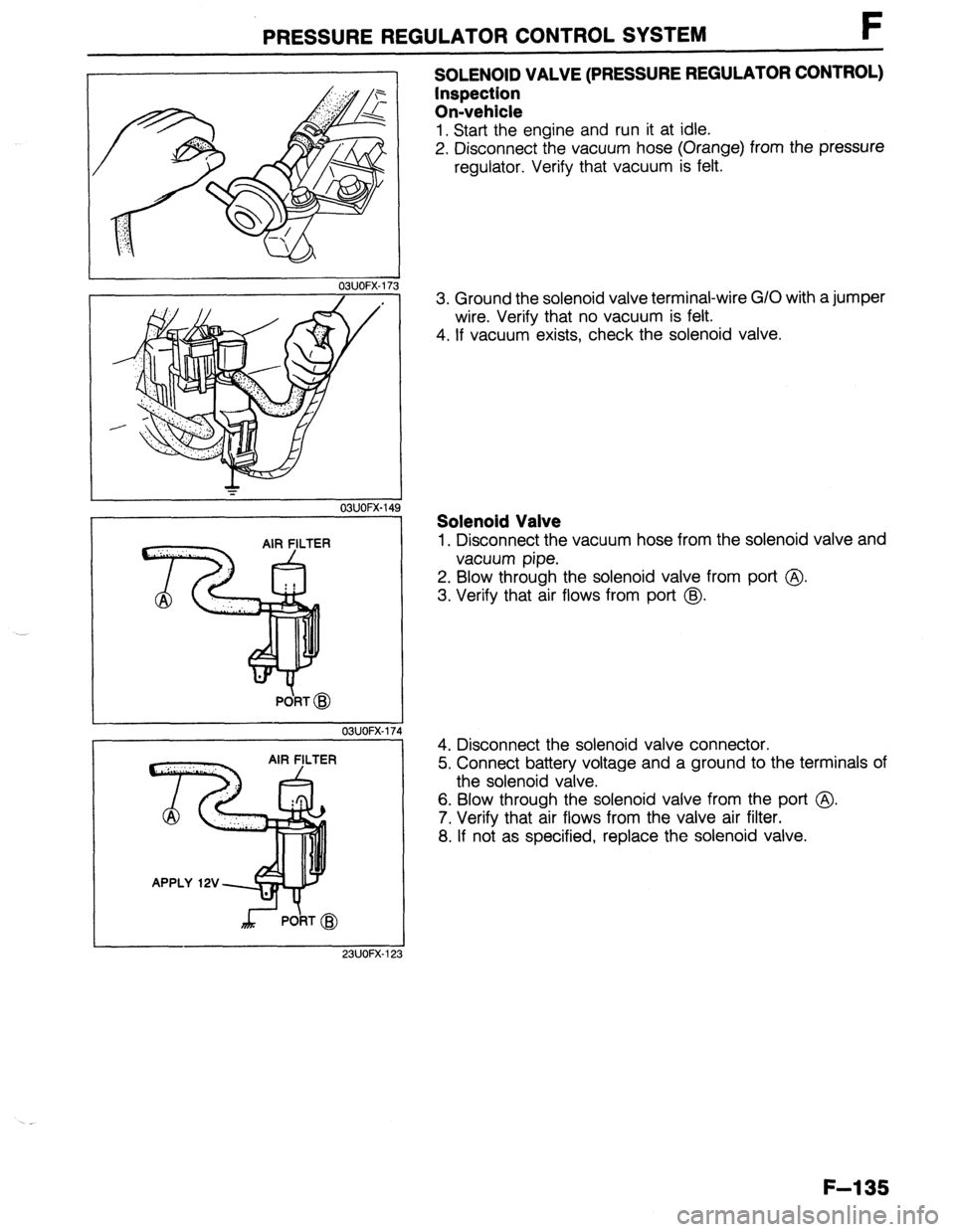
PRESSUREREGULATORCONTROLSYSTEM F
03UOFX-17
*
03UOFX-14!
OSUOFX-17
SOLENOID VALVE (PRESSURE REGULATOR CONTROL)
Inspection
On-vehicle
1. Start the engine and run it at idle.
2. Disconnect the vacuum hose (Orange) from the pressure
regulator. Verify that vacuum is felt.
3. Ground the solenoid valve terminal-wire G/O with a jumper
wire. Verify that no vacuum is felt.
4. If vacuum exists, check the solenoid valve.
Solenoid Valve
1. Disconnect the vacuum hose from the solenoid valve and
vacuum pipe.
2. Blow through the solenoid valve from port @
3. Verify that air flows from port @.
4. Disconnect the solenoid valve connector.
5. Connect battery voltage and a ground to the terminals of
the solenoid valve.
6. Blow through the solenoid valve from the port @.
7. Verify that air flows from the valve air filter.
8. If not as specified, replace the solenoid valve.
F-l 35
Page 416 of 1164

CONTROL SYSTEM
Terminal voltage (MTX)
VB: Battery voltage
wminal Input Output Connection to Test condition Correct voltage Remark
1A - - Battery Constant VB For backup
1B 0 Main relay OFF OV
(FUEL INJ relay) Ignition switch ._-
ON VB
1c 0 Ignition switch While cranking Approx. 10V
(START) -
Ignition switch ON ov
10 0 Self-Diagnosis Test switch at “SELF-TEST” With Self-
Checker Lamp illuminated for 3 sec. after ignition 4.5--5.5v Diagnosis Check-
(Monitor lamp) switch OFF+ON er and System
Lamp not illuminated after 3 sec. VEI Selector
Test switch at “02 MONITOR” at idle
Monitor lamp illuminated 4.5-5.5v
Test switch at
“02 MONITOR” at idle
Monitor lamp not illuminated Va
1E 0 Malfunction indica- Lamp illuminated for 3 sec. after ignition
Below 2.5V With System
tor lamp (MIL) switch OFF-ON Selector test
Lamp not illuminated after 3 sec.
VB switch at
“SELF-TEST”
Lamp illuminated Below 2.5V
Lamp not illuminated VR
1F
0 Self-Diagnosis Buzzer sounded for 3 sec. after ignition
Below 2.5V
l With Self-
Checker switch OFF+ON Diagnosis
(Code Number)
Buzzer not sounded after 3 sec. VE - Checker and
Buzzer sounded Below 2.5V System Selector
l With System
Buzzer not sounded
VB Selector test
switch at
“SELF-TEST”
1G 0 Igniter Ignition switch ON ov
-
Idle Approx. 0.2V
1H - - - - - -
_-
II - - - - - -
1J
0 AIC relay Ignition switch ON
VB
A/C switch ON at idle Below 2.5V
A/C switch OFF at idle VB
-
1K 0 Diagnosis
connector
(TEN terminal) System Selector test switch at
“02 MONITOR”
System Selector test switch at
“SELF-TEST” VB
ov Ignition switch
ON
1L 0 DRL relay
(Canada) Parking brake pulled with ignition switch
Ve
l DRL.: Daytime
ON (DRL OFF) Running Lights
Idle (DRL ON) Below 2.5V
V’
F-l 50
Page 417 of 1164

CONTROL SYSTEM F
VB: Battery voltage
incorrect voltage POBSible cause
Alwvs OV’ l ROOM IOA fuse burned l Open circuit in wiring from ROOM IOA fuse to ECU terminal 1A
Always OV
l Main relay malfunction (Refer to page F-171) l Open or short circuit in wiring from main relay to ECU terminal 1B
I
Always OV (Starter turns) l Open or short circuit in wiring from starter interlock switch (USA), ignition
switch (CANADA), to ECU terminal 1C
I
Always OV
Always Vs
Always approx. 5V
l Main relay (FUEL IWJ relay) malfunction (Refer to page F-171) l Open circuit in wiring from main relay to diagnosis connector terminal +B l Open or short circuit in wiring from diagnosis connector terminal MEN to
ECU terminal 1D
l Poor connection at ECU connector l ECU malfunction
l ECU malfunction
Always below
23 MIL always ON
MIL never ON
l Short circuit in wiring from combination meter to ECU terminal 1E l ECU malfunction
l Open circuit in wiring from combination meter to ECU terminal 1E
I
Always Ve l Poor connection at ECU connector l ECU malfunction
Always below
2.5V
Always
VB
No display on Self- * Main relay (FUEL INJ relay) malfunction (Refer to page F-171)
Diagnosis Checker l Open circuit in wiring from main relay to diagnosis connector terminal +B
“88” displayed and
l Open or short circuit in wiring from diagnosis connector terminal FEN to
buzzer sounds con- ECU terminal 1F
tinuously
l Poor connectron at ECU connector l ECU malfunction
Always OV
l Short circuit in wiring from igniter to ECU terminal 1G
I -
I -
I
I -
I -
I
Always below
2.5V
Always VB AIC does not operate l A/C relay malfunction (Refer to page U-55) l Open circurt in wiring from ignition switch to A/C relay l Open circuit in wiring from A/C relay to ECU terminal 1J
A/C switch OFF but
l Short circuit in wiring from A/C relay to ECU terminal IJ
AIC operates l ECU malfunction
l Poor connection at ECU connector l ECU malfunction
Always below l.OV
l Short circuit in wiring from diagnosis connector terminal TEN to ECU termi-
nal 1K
Always Vs
l Open circuit in wiring from diagnosis connector terminal TEN to ECU termi-
nal 1K
l Open circuit in wiring from diaonosis connector terminal GND to ground
Always below
2.W
Always Va DRL ON when ignition
l Short circuit in wiring from DRL relay to ECU terminal IL
switch ON l Short circuit in wiring from DRL relay to DRL unit
DRL never ON
l Open circuit in wiring from DRL relay to ignition switch
l Parking brake switch always ON l DRL unit malfunction (Refer to page T-33)
23UOFX- 134
F-l 51
Page 418 of 1164

F CONTROL SYSTEM
VB: Battery voltage
erminal Input Output Connection to Test condition Corrsct voltage Remark
1M - - - - - -
IN 0 Throttle sensor Accelerator pedal released ov Ignition switch
(Idle switch)
Accelerator pedal depressed
VB ON
10 0
1P 0 Stoplight switch
P/S pressure
switch Brake pedal released
Brake pedal depressed
Ignition switch ON
P/S ON at idle
P/S OFF at idle ov
-
VEi
Va
ov
VS -
10 0 A/C switch A/C switch ON
A/C switch OFF Below 23 Ignition switch
VS ON and blower
motor ON
1R 0
IS 0 Fan switch
Blower control
switch Fan operating (Engine coolant tempera-
ture over 97% (207OF) or diagnosis con-
nector terminal TFA grounded)
Fan not operating (Idle)
Blower control switch OFF or 1st position
Blower control switch 2nd or higher po-
sition ov
-
V0
Ve ignition switch
ov ON
IT 0 Rear window
defroster switch Rear window defroster switch OFF
Rear window defroster switch ON ov
VB
Ignition switch ON
1u 0
iv 0 Headlight switch
Neutral/Clutch
switches Headlights ON
Headlights OFF
Neutral position or clutch pedal
depressed
Others V0
-
ov
ov
VB -
1 I lr----t
r-i
ul r
2Y 2w 2u 2s 20 20 2M 2K 21 2G 2E 2’3 2A 1lJ 1s IQ 10 1M 1K 11 1G 1E 1~ 1A
22 2x 2v 2T 2R 2P 2N 2L 2J 34 2t= 2D 28 Ii/ fT 1R 1p IN 1L 1J 1H 1F 1D 18
F-l 52
Page 419 of 1164

CONTROL SYSTEM F
Ve: Battery voltage
Incorrect voltage
1, -
Always below l.OV
Always Ve
Always below I.OV (Stoplight OK)
Always below l.OV
Always
VB
Always below 25V (Blower fan OK)
Always
VB (Blower fan OK)
Always below 1 .OV
(Electrical cooling fan OK)
Always below 1 .OV (Blower fan OK)
Always
VB (Blower fan OK)
Always below
1 .ov
Always below l.OV Illumination lamp
ON when rear
window defroster
switch ON
Illumination lamp
never ON
(Headlights OK)
Always below l.OV
Always Ve Possible cause
-
l Throttle sensor misadjustment (Refer to page F-169)
l Short circuit in wiring from throttle sensor to ECU terminal 1N l ECU malfunction
l Throttle sensor misadjustment (Refer to page F-169) l Open circuit in wiring from throttle sensor to ECU terminal IN l Open circuit in wiring from throttle sensor to ECU terminal 2D
l Open circuit in wiring from stoplight switch to ECU terminal 10
l P/S pressure switch malfunction (Refer to page F-173) l Short circuit in wiring from P/S pressure switch to ECU terminal 1P l ECU malfunction
l P/S pressure switch malfunction (Refer to page F-173) l Open circuit in wiring from P/S pressure switch to ECU terminal 1P l Open circuit in wiring from P/S pressure switch to ground
l A/C switch malfunction (Refer to page U-55) l Short circuit in wiring from A/C switch to ECU terminal 10 l Poor connection at ECU connector l ECU malfunction
l A/C switch malfunction (Refer to page U-55) l Open circuit in wiring from A/C switch to ECU terminal 1Q l Open circuit in wirina from A/C switch to blower control switch
l Open or short circuit in wiring from fan relay to ECU terminal 1R l ECU malfunction
l Short circuit in wiring from blower control switch to ECU terminal 1s l Poor connection at ECU connector l ECU malfunction
l Open circuit in wiring from blower control switch to ECU terminal IS
I
l Open or short circuit in wiring from rear window defroster switch to ECU
terminal 1 T
l Open circuit in wiring from ignition switch to rear window defroster switch l Rear window defroster switch malfunction (Refer to page T-21)
l Open or short circuit in wiring from headlight relay to ECU terminal 1U
(Refer to page F-152)
l Neutral switch malfunction (Refer to page F-173) l Clutch switch malfunction (Refer to page F-172) l Short circuit in wirino from ECU terminal IV to neutral or clutch switch
l Neutral switch malfunction (Refer to page F-173) l Clutch switch malfunction (Refer to page F-172) l Open circuit in wiring from ECU terminal 1V to neutral or clutch switch l Poor connection at ECU connector
23UOFX-136
F-l 53
Page 420 of 1164

CONTROL SYSTEM
Ve: Battery
arminal Input Output Connection to lest condition Correct voltage Remark
2A - - Ground (Injector) Constant ov -
28 - - Ground (Output) Constant ov -
2c - - Ground (CPU) Constant ov -
2D - - Ground (Input) Constant ov -
2E 0 Distributor Ignition switch ON
Approx. OV
(Ne-signal) or 4.5-5.5V -
Idle Approx. 2V
2F - - - - - -
2G 0 Distributor Ignition switch ON Approx. OV
(G-signal) [DOHC] or 4.5-5.5V
Idle Approx. 1.5V
2H 0 Ground (California) Constant ov
-
Main relay Ignition switch ON Va
(Canada)
21 - - - - - -
2J 0 Open Constant Approx. l-29 -
2K 0 Throttle sensor Constant 4.5-5.5v
(ATX)/Airflow meter
-
2L 0 Throttle sensor
(Power switch) Accelerator pedal released
Accelerator pedal fully depressed Approx. 4.5~5%
ov -
2M 0 Throttle sensor Accelerator pedal released
Accelerator pedal fully depressed Approx. 0.5V
Approx. 4.OV -
2N 0 Oxygen sensor Ignition switch ON ov
Idle (Cold engine) ov
Idle (After warm-up) O-l .ov -
Increasing engine speed (After warm-up) 0.5-I .ov
Deceleration o-0.4v
20 0 Airflow meter Ignition switch ON Approx. 3.8V
-
Idle Approx. 3.3V
2P 0 Intake air ther- Ambient air temperature 20% (68OF) Approx. 2.5V Built in airflow
mosensor meter
2Q 0 Water thermo- Engine coolant temperature 20% (68’F) Approx. 29
_
sensor
After warm-up Below 0.5V
2R - - - - -
- 711 ICIFX-12 voltage
_““_. ,. .I 7
1 r u-
r-i Ll r
2Y 2w 2u 2s 20 20 2M 2K 21 2G 2E 2~2 2A 1U 1s 1Q 10 lft,j ,K ,, ,G ,E ,c ,A
22 2x 2v 2T 2R 2P 2N 2L 2J 2H 2F 2D 28
IV 1T fR 1p 1N 1L 1J ,H IF ID ,B
F-l 54